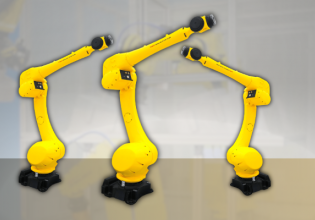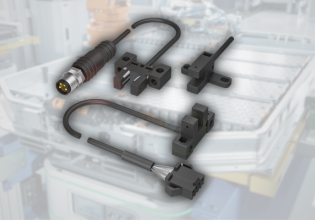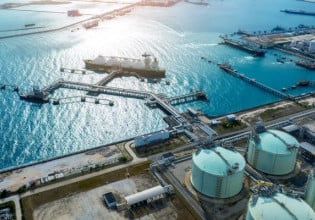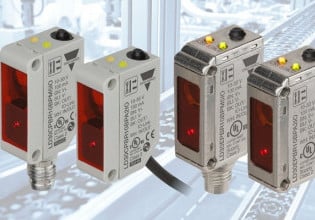Flow Rate Sensors for Measurement in Fluid Systems
Flow sensors measure the flow rate of liquids or gasses in pipes, ducts, and other fluid systems to help monitor and control processes, prevent system failures, and optimize performance.
See Our Previous Articles on Industrial Sensors:
- Infrared Sensors for Automation
- Temperature Sensors and Their Uses
- Magnetic and Inductive Sensing
- Pressure Sensor Fundamentals and Types
- Level Sensors For Use in Level Measurement
What Is a Flow Rate Sensor?
Flow rate sensors are essential in many industrial applications, helping monitor and control processes, prevent system failures, and optimize performance. These sensors measure the flow rate of liquids or gasses in pipes, ducts, and other fluid systems by determining either velocity or the mass flow rate in a process stream.
The basic working principle behind flow rate sensors is based on the fundamentals of flow dynamics. First, it is established that mass is a conserved quantity that cannot be created or destroyed, or in other words, remains constant regardless of its containing boundaries. Then, in any situation where there is a mass flow, the mass that comes in equals the mass that goes out.

Figure 1. A complex piping system in an industrial environment. Image used courtesy of Adobe Stock
There are different techniques for measuring this mass flow in terms of velocity, which is proportional to the flow rate, depending on the type of sensor used. In general, flow rate sensors measure the fluid’s velocity at a specific point in the system (with a known cross-sectional area) and use this measurement to estimate the volumetric flow rate.
Various flow rate sensors are available today, each with particular working principles, advantages, and limitations. This article will review the flow rate sensors: differential pressure, electromagnetic, heat transfer, and ultrasonic sensors.
Differential Pressure Sensor
Differential pressure sensors are one of the most common flow sensors used in the industry. Differential pressure sensors work by measuring the pressure difference between two points of a fluid system. A pressure difference is created by forcing the fluid through a constriction, usually a smaller pipe diameter, increasing its velocity. Then, two pressure ports are positioned, one upstream and one downstream of the constriction. The resulting pressure differential is used to calculate the flow rate.

Figure 2. A Venturi flow meter with its characteristic conical shape constriction. Image used courtesy of Primary Flow Signal
One common form of the differential pressure sensor is the Venturi meter. These sensors employ Bernoulli’s equation, which states that the flow of a fluid has constant energy at every point, establishing a proportional relationship between the two pressure points.
Differential pressure sensors are relatively simple to build compared to other flow meters. They are also widely regarded as reliable and cost-effective. In addition, these sensors are versatile because they can be used in a wide range of fluids and flow rates. On the other hand, differential pressure sensors can be prone to errors if improperly calibrated. They are also sensitive to rapid changes in fluid properties such as temperature and viscosity. Also, sensor design is crucial to avoid unwanted pressure drops in the fluid system.
Electromagnetic Flow Meter
Electromagnetic flow rate sensors (flow meters) are designed based on Faraday’s law of electromagnetic induction. Faraday’s law establishes a relationship between a magnetic field and the current induced onto an electrical conductor.

Figure 3. A representation of an electromagnetic flow rate sensor. Image used courtesy of Eltra Trade
In flow rate measurement, electromagnetic sensors generate a magnetic field across the fluid and measure the induced voltage in the fluid as it flows through the magnetic field. The induced voltage is proportional to the fluid velocity and, thus, the flow rate.
Electromagnetic flow rate sensors can be used in conductive and non-conductive fluids. Two advantages they have over differential pressure sensors are that they do not create pressure drops in the system and they are not affected by temperature or other changes in the fluid. However, they are generally more expensive and require regular calibration to maintain accuracy.
Heat Transfer Flow Sensor
Heat transfer is essential in flow rate sensors because heat transfer between fluid and sensor depends on the fluid velocity. The higher the fluid velocity, the higher the heat transfer rate. This rate can be measured using different methods, such as thermal conduction, convection, or radiation.

Figure 4. A diagram of an in-line heat-transfer flow rate sensor. Image used courtesy of Sierra Instruments
A heated element, known as a thermistor, is placed inside the fluid stream. Then, as the fluid flows past the sensor, heat is transferred to the fluid, changing the sensor’s temperature. This temperature change is proportional to the fluid velocity and flow rate.
Like electromagnetic sensors, heat transfer sensors do not create pressure drops in the system and are unaffected by fluid viscosity changes.
Ultrasonic Flow Rate Sensors
These sensors are based on the Doppler effect and employ ultrasonic waves to measure flow. The Doppler effect explains a wave’s frequency shift when it reflects off a moving object.

Figure 5. An example of an ultrasonic sensor assembly. Image used courtesy of CeramTec
Ultrasonic flow rate sensors consist of two transducers on opposite sides of a duct carrying the fluid. One transducer emits ultrasonic waves, and the other receives the waves. The waves’ frequency change as they pass through the fluid is proportional to the fluid velocity.
These sensors are minimally invasive because they do not require the sensor to be in direct contact with the fluid. This feature makes them well-suited for measuring corrosive or abrasive fluids. They are also regarded as reliable because of their high repeatability.
Industrial Sensing
In the next article in our series, we will take a closer look at micro-electro-mechanical systems (MEMS) sensors and the types used in industrial automation.






